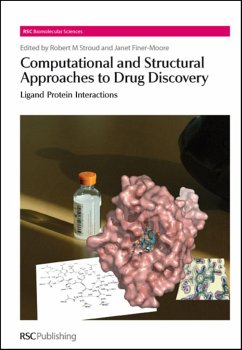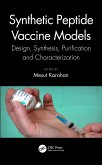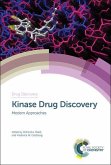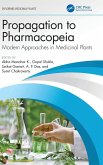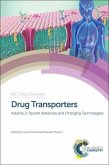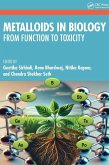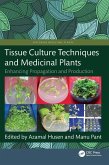Computational and Structural Approaches to Drug Discovery
Ligand-Protein Interactions
Herausgeber: Stroud, Robert; Finer-Moore, Janet
Computational and Structural Approaches to Drug Discovery
Ligand-Protein Interactions
Herausgeber: Stroud, Robert; Finer-Moore, Janet
- Gebundenes Buch
- Merkliste
- Auf die Merkliste
- Bewerten Bewerten
- Teilen
- Produkt teilen
- Produkterinnerung
- Produkterinnerung
Computational methods impact all aspects of modern drug discovery and most notably these methods move rapidly from academic exercises to becoming drugs in clinical trials. This insightful book represents the experience and understanding of the global experts in the field and spotlights both the structural and medicinal chemistry aspects of drug design. The need to 'encode' the factors that determine adsorption, distribution, metabolism, excretion and toxicology are explored, as they remain the critical issues in this area of research. Addressing a wide range of uses of protein structures for…mehr
Andere Kunden interessierten sich auch für
![Synthetic Peptide Vaccine Models Synthetic Peptide Vaccine Models]() Synthetic Peptide Vaccine Models164,99 €
Synthetic Peptide Vaccine Models164,99 €![Kinase Drug Discovery Kinase Drug Discovery]() Kinase Drug Discovery236,99 €
Kinase Drug Discovery236,99 €![Propagation to Pharmacopeia Propagation to Pharmacopeia]() Propagation to Pharmacopeia135,99 €
Propagation to Pharmacopeia135,99 €![Drug Transporters Drug Transporters]() Drug Transporters205,99 €
Drug Transporters205,99 €![Metalloids in Biology Metalloids in Biology]() Metalloids in Biology142,99 €
Metalloids in Biology142,99 €![Tissue Culture Techniques and Medicinal Plants Tissue Culture Techniques and Medicinal Plants]() Tissue Culture Techniques and Medicinal Plants212,99 €
Tissue Culture Techniques and Medicinal Plants212,99 €![Sphingolipids as Signaling and Regulatory Molecules Sphingolipids as Signaling and Regulatory Molecules]() Sphingolipids as Signaling and Regulatory Molecules225,99 €
Sphingolipids as Signaling and Regulatory Molecules225,99 €-
-
-
Computational methods impact all aspects of modern drug discovery and most notably these methods move rapidly from academic exercises to becoming drugs in clinical trials. This insightful book represents the experience and understanding of the global experts in the field and spotlights both the structural and medicinal chemistry aspects of drug design. The need to 'encode' the factors that determine adsorption, distribution, metabolism, excretion and toxicology are explored, as they remain the critical issues in this area of research. Addressing a wide range of uses of protein structures for drug discovery, the Editors have created an essential reference for professionals in the pharmaceutical industry and a core text for all graduate level courses covering molecular interactions and drug discovery.
Produktdetails
- Produktdetails
- Verlag: RSC Publishing
- Seitenzahl: 400
- Erscheinungstermin: 26. Oktober 2007
- Englisch
- Abmessung: 241mm x 164mm x 27mm
- Gewicht: 757g
- ISBN-13: 9780854043651
- ISBN-10: 0854043659
- Artikelnr.: 22960495
- Herstellerkennzeichnung
- Libri GmbH
- Europaallee 1
- 36244 Bad Hersfeld
- gpsr@libri.de
- Verlag: RSC Publishing
- Seitenzahl: 400
- Erscheinungstermin: 26. Oktober 2007
- Englisch
- Abmessung: 241mm x 164mm x 27mm
- Gewicht: 757g
- ISBN-13: 9780854043651
- ISBN-10: 0854043659
- Artikelnr.: 22960495
- Herstellerkennzeichnung
- Libri GmbH
- Europaallee 1
- 36244 Bad Hersfeld
- gpsr@libri.de
Robert M. Stroud is a professor at the University of California and has been a fellow of the Royal Society of Medicine (UK) since 1992 and a member of the National Academt of Sciences (US) since 2003. His prestigious career spans over 35 years and he is and has served on the scientific advisory boards of many companies and institutions including the National Cancer Institute, the Neutron Diffraction facility, Axys Pharmaceuticals, and Sunesis Phamraceuticals. Janet Finer-Moore is a Research Biologist at the University of California Her contribution to the detailed determination of the structural and chemical mechanism of a two substrate enzyme and detection of amphipathic helices in protein and gene sequences have perpetuated over 28 publications. She is a member of the AAAS, the ACA, the ACS and the Biophysical Society.
Preface: Section 1 Overview: 1 Facing the Wall in Computationally Based Approaches to Drug Discovery
1.1 The promise, and the problem
1.2 Current limitations in structure-guided lead design
1.3 Lessons in structure-based drug design from thymidylate synthase research
1.3.1 Mechanism-based inhibitors and enzyme-catalyzed therapeutics
1.3.2 Iterative structure-based drug design
1.3.3 Docking, fragments and optimizability
1.4 New developments in structure-based drug-design methods
1.4.1 Fragment-based methods
1.4.2 Identifying drug target sites on a protein
1.4.3 Targeting protein-protein interactions
1.4.4 Computational docking to nominated sites
1.5 Conclusion
References
2 The Changing Landscape in Drug Discovery
2.1 Introduction
2.2 QSAR - understanding without prediction
2.3 Gene technology - from mice to humans
2.4 Combinatorial library design - driven by medicinal chemistry
2.5 Docking and scoring - solved and unsolved problems
2.6 Virtual screening - the road to success
2.7 Fragment-based and combinatorial design - a new challenge
2.8 Summary and conclusions
References
Section 2: Structure-Based Design
3 Purine Nucleoside Phosphorylase
3.1 Introduction
3.2 Three-dimensional structures of PNPs
3.3 Related enzymes of the PNP family
3.4 PNP active sites
3.5 Human PNP inhibitors
3.6 Other applications of molecular design to PNP
3.7 Applications of molecular design to enzymes related to PNP
3.8 PNP inhibitors and clinical trials
3.9 Conclusions and future directions
References
4 Application and Limitations of X-Ray Crystallographic Data in Structure-Based Ligand and Drug Design
4.1. Introduction
4.2. Structure-based ligand design and drug design
4.3 Some limitations in the use of X-ray data
4.3.1 Basic crystallography terms
4.3.2 Uncertainty in the identity or location of protein or ligand atoms
4.3.3 Effect of crystallization conditions
4.3.4 Identification and location of water
4.4 Macromolecular structures to determine small-molecule structures
4.5 Assessing the validity of structure models
4.6 Summary and Outlook
References
5 Dealing with Bound Waters in a Site: Do they Leave or Stay?
5.1 Introduction
5.2 Localized water molecules in binding sites of proteins
5.3 Identifying localized water molecules from computer simulations
5.4 Calculation of free-energy cost of displacing a site-bound water molecule
5.5 Inclusion of explicit water molecules in drug discovery
Acknowledgements
References
6 Knowledge-Based Methods in Structure-Based Design
6.1 Introduction
6.2 Atom-based potentials
6.3 Group-based potentials
6.4 Methodologies
6.4.1 The reference state
6.4.2 Volume corrections
6.5 Applications
6.5.1 Visualization and interaction 'hot spots'
6.5.2 Docking and scoring
6.5.3 De novo design
6.5.4 Targeted scoring functions
6.6 Discussion
6.7 Conclusion
References
7 Combating Drug Resistance -Identifying Resilient Molecular Targets and Robust Drugs
7.1 Introduction
7.2 Resilient targets and robust drugs
7.3 Example of HIV-1 protease: substrate recognition vs. drug resistance
7.4 Implications for future structure-based drug design
Acknowledgements
References
Section 3: Docking
8 Docking Algorithms and Scoring Functions
State-of-the-Art and Current Limitations
8.1 Introduction
8.1.1 Binding mode prediction
8.1.2 Virtual screening for lead identification
8.1.3 Potency prediction for lead optimization
8.2 A brief review of recent docking evaluations
8.3 What these evaluations tell us about the performance of docking algorithms
8.3.1 Binding mode prediction
8.3.2 Virtual screening
8.3.3 Affinity prediction
8.4 How an ideal evaluation data set might be structured
8.4.1 Binding mode prediction
8.4.2 Virtual screening
8.4.3 Affinity prediction
8.5 Concluding remarks
8.5.1 Binding mode prediction
8.5.2 Virtual screening
8.5.3 Rank order by affinity
8.5.4 The state-of-the-art
References
9 Application of Docking Methods to Structure-Based Drug Design
9.1 Introduction
9.2.1 Molecule preparation
9.2.2 Sampling methods
9.2.3 Scoring methods
9.2.4 Managing errors in docking
9.4 Docking methods, capabilities and limitations
9.5 Summary
References
10 Strength in Flexibility: Modeling Side-Chain Conformational Change in Docking and Screening
10.1 Introduction
10.2 Background
10.2.1 Improving docking and screening through side-chain flexibility modeling
10.2.2 Enhancing target specificity through flexibility modeling
10.3 Approaches
10.3.1 The state of the art in modeling protein side-chain flexibility
10.3.2 Learning from nature: observing side-chain motions upon ligand binding
10.4 The future: knowledge-based modeling of side-chain motions
Acknowledgements
References
11 Avoiding the rigid receptor: side chain rotamers
11.1 Introduction
11.2 Rotamer libraries
11.3 Successful applications of rotamer libraries in drug design
11.3.1 Aspartic acid protease inhibitors
11.3.2 Matrix metalloproteinase-1 inhibitors
11.3.3 Thymidylate synthase inhibitors
11.3.4 Protein tyrosine phosphatase 1B inhibitors
11.3.5 HIV protease drug-resistant mutants bound to inhibitors
11.3.6 Trypsin-benzamidine and phosphocholine-McPC 603
11.4 Conclusions
Acknowledgements
References
Section 4: Screening
12 Computational Prediction of Aqueous Solubility, Oral Bioavailability, P450 Activity and hERG Channel Blockade
12.1 Introduction
12.2 Aqueous solubility
12.3 Oral bioavailability
12.4 P450 activity
12.5 hERG channel blockade
12.6 Conclusions
References
13 Shadows on Screens
13.1 Introduction
13.2 Phenomenology of aggregation
13.3 What sort of compounds aggregate?
13.4 Mechanism of aggregation-based inhibition
13.5 A rapid counter-screen for aggregation-based inhibitors
13.6 Biological implications?
13.7 The spirit-haunted world of screening
Acknowledgements
References
14 Iterative Docking Strategies for Virtual Ligand Screening
14.1 Introduction
14.2 AutoDock background
14.2.1 Scoring function
14.2.2 Search function
14.2.3 AutoDockTools
14.2.4 AutoDockTools analysis
14.3 Diversity-based virtual ligand screening
14.3.1 AICAR transformylase
14.3.2 Protein phosphatase 2C
14.4 Comparison with existing VLS strategies
14.4.1 Hierarchical VLS
14.4.2 Monolithic VLS strategy
14.5 Other AutoDock VLS strategies
14.5.1 Acetylcholine esterase peripheral anionic site
14.5.2 Human P2Y1 receptor
14.6 Diversity-based VLS issues
14.6.1 Library choice
14.6.2 Similarity search
14.6.3 Apo versus ligand-bound docking models
14.6.4 Binding site choices
14.7 Future work
References
15 Challenges and Progresses in Calculations of Binding Free Energies
What Does it Take to Quantify Electrostatic Contributions to Protein-Ligand Interactions
15.1 Introduction
15.2 Computational strategies
15.2.1 Free-energy perturbation, linear response approximation and potential of mean force calculations by all-atom models
15.2.2 Proper and improper treatments of long-range effects in all-atom models
15.2.3 Calculations of electrostatic energies by simplified models
15.3 Calculating binding free energies
15.3.1 Studies of drug mutations by FEP approaches
15.3.2 Evaluation of absolute binding energies by the LRA and LIE approaches
15.3.3 Using semi-macroscopic and macroscopic approaches in studies of ligand binding
15.3.4 Protein-protein interactions
15.4 Challenges and new advances
15.5 Perspectives
Acknowledgements
References
Section 5: Fragment-Based Design
16 Discovery and Extrapolation of Fragment Structures towards Drug Design
16.1 Structure-based approaches to drug discovery
16.2 Properties of molecular fragments
16.3 From molecular fragments to drug leads
16.3.1 Fragment growing
16.3.2 Fragment linking
16.3.3 Fragment assembly
16.4 Screening and identification of fragments
16.5 X-Ray crystallography for fragment-based lead identification
16.6 NMR spectroscopy
16.6.1 Protein-based methods: structure-activity relationship by NMR
16.6.2 Ligand-based methods
16.7 Mass spectrometry
16.7.1 Covalent mass spectrometric methods
16.7.2 Non-covalent mass spectrometric methods
16.7.3 Looking at the protein or the ligand
16.8 Thermal shift
16.9 Isothermal titration calorimetry
16.10 Surface plasmon resonance
16.11 Concluding remarks
Acknowledgements
References
17 A Link Means a Lot: Disulfide Tethering in Structure-Based Drug Design
17.1 Introduction: what is disulfide Tethering?
17.2 Successes of native cysteine Tethering
17.3 Role of structure in engineered-cysteine Tethering
17.4 Cooperative Tethering
17.5 Extended Tethering
17.6 Break-away Tethering
17.7 Discovery of novel allosteric sites with Tethering
17.8 Tethering as a validation tool
17.9 Tethering vs. traditional medicinal chemistry
17.10 Tethering in structure determination
17.11 The challenge of covalency
17.12 Hydrophobic binders
17.13 Conclusions: the future of Tethering
References
18 The Impact of Protein Kinase Structures on Drug Discovery
18.1 Introduction
18.2 The hinge region and the concept of kinase inhibitor scaffold
18.3 High-throughput crystallography for the discovery of novel scaffolds
18.3.1
High-throughput crystallography for the discovery of novel scaffolds
18.3.2 Low potency, low specificity, and low molecular weight screening
18.4 The gatekeeper residue and the selectivity pocket
18.5 The conformational states of the DFG motif and the opening of the back pocket
18.6 Allosteric inhibitors, non-ATP competitive inhibitors, and irreversible inhibitors
18.7 Discovering kinase inhibitors in a 500-dimensional space
Acknowledgements
References
1.1 The promise, and the problem
1.2 Current limitations in structure-guided lead design
1.3 Lessons in structure-based drug design from thymidylate synthase research
1.3.1 Mechanism-based inhibitors and enzyme-catalyzed therapeutics
1.3.2 Iterative structure-based drug design
1.3.3 Docking, fragments and optimizability
1.4 New developments in structure-based drug-design methods
1.4.1 Fragment-based methods
1.4.2 Identifying drug target sites on a protein
1.4.3 Targeting protein-protein interactions
1.4.4 Computational docking to nominated sites
1.5 Conclusion
References
2 The Changing Landscape in Drug Discovery
2.1 Introduction
2.2 QSAR - understanding without prediction
2.3 Gene technology - from mice to humans
2.4 Combinatorial library design - driven by medicinal chemistry
2.5 Docking and scoring - solved and unsolved problems
2.6 Virtual screening - the road to success
2.7 Fragment-based and combinatorial design - a new challenge
2.8 Summary and conclusions
References
Section 2: Structure-Based Design
3 Purine Nucleoside Phosphorylase
3.1 Introduction
3.2 Three-dimensional structures of PNPs
3.3 Related enzymes of the PNP family
3.4 PNP active sites
3.5 Human PNP inhibitors
3.6 Other applications of molecular design to PNP
3.7 Applications of molecular design to enzymes related to PNP
3.8 PNP inhibitors and clinical trials
3.9 Conclusions and future directions
References
4 Application and Limitations of X-Ray Crystallographic Data in Structure-Based Ligand and Drug Design
4.1. Introduction
4.2. Structure-based ligand design and drug design
4.3 Some limitations in the use of X-ray data
4.3.1 Basic crystallography terms
4.3.2 Uncertainty in the identity or location of protein or ligand atoms
4.3.3 Effect of crystallization conditions
4.3.4 Identification and location of water
4.4 Macromolecular structures to determine small-molecule structures
4.5 Assessing the validity of structure models
4.6 Summary and Outlook
References
5 Dealing with Bound Waters in a Site: Do they Leave or Stay?
5.1 Introduction
5.2 Localized water molecules in binding sites of proteins
5.3 Identifying localized water molecules from computer simulations
5.4 Calculation of free-energy cost of displacing a site-bound water molecule
5.5 Inclusion of explicit water molecules in drug discovery
Acknowledgements
References
6 Knowledge-Based Methods in Structure-Based Design
6.1 Introduction
6.2 Atom-based potentials
6.3 Group-based potentials
6.4 Methodologies
6.4.1 The reference state
6.4.2 Volume corrections
6.5 Applications
6.5.1 Visualization and interaction 'hot spots'
6.5.2 Docking and scoring
6.5.3 De novo design
6.5.4 Targeted scoring functions
6.6 Discussion
6.7 Conclusion
References
7 Combating Drug Resistance -Identifying Resilient Molecular Targets and Robust Drugs
7.1 Introduction
7.2 Resilient targets and robust drugs
7.3 Example of HIV-1 protease: substrate recognition vs. drug resistance
7.4 Implications for future structure-based drug design
Acknowledgements
References
Section 3: Docking
8 Docking Algorithms and Scoring Functions
State-of-the-Art and Current Limitations
8.1 Introduction
8.1.1 Binding mode prediction
8.1.2 Virtual screening for lead identification
8.1.3 Potency prediction for lead optimization
8.2 A brief review of recent docking evaluations
8.3 What these evaluations tell us about the performance of docking algorithms
8.3.1 Binding mode prediction
8.3.2 Virtual screening
8.3.3 Affinity prediction
8.4 How an ideal evaluation data set might be structured
8.4.1 Binding mode prediction
8.4.2 Virtual screening
8.4.3 Affinity prediction
8.5 Concluding remarks
8.5.1 Binding mode prediction
8.5.2 Virtual screening
8.5.3 Rank order by affinity
8.5.4 The state-of-the-art
References
9 Application of Docking Methods to Structure-Based Drug Design
9.1 Introduction
9.2.1 Molecule preparation
9.2.2 Sampling methods
9.2.3 Scoring methods
9.2.4 Managing errors in docking
9.4 Docking methods, capabilities and limitations
9.5 Summary
References
10 Strength in Flexibility: Modeling Side-Chain Conformational Change in Docking and Screening
10.1 Introduction
10.2 Background
10.2.1 Improving docking and screening through side-chain flexibility modeling
10.2.2 Enhancing target specificity through flexibility modeling
10.3 Approaches
10.3.1 The state of the art in modeling protein side-chain flexibility
10.3.2 Learning from nature: observing side-chain motions upon ligand binding
10.4 The future: knowledge-based modeling of side-chain motions
Acknowledgements
References
11 Avoiding the rigid receptor: side chain rotamers
11.1 Introduction
11.2 Rotamer libraries
11.3 Successful applications of rotamer libraries in drug design
11.3.1 Aspartic acid protease inhibitors
11.3.2 Matrix metalloproteinase-1 inhibitors
11.3.3 Thymidylate synthase inhibitors
11.3.4 Protein tyrosine phosphatase 1B inhibitors
11.3.5 HIV protease drug-resistant mutants bound to inhibitors
11.3.6 Trypsin-benzamidine and phosphocholine-McPC 603
11.4 Conclusions
Acknowledgements
References
Section 4: Screening
12 Computational Prediction of Aqueous Solubility, Oral Bioavailability, P450 Activity and hERG Channel Blockade
12.1 Introduction
12.2 Aqueous solubility
12.3 Oral bioavailability
12.4 P450 activity
12.5 hERG channel blockade
12.6 Conclusions
References
13 Shadows on Screens
13.1 Introduction
13.2 Phenomenology of aggregation
13.3 What sort of compounds aggregate?
13.4 Mechanism of aggregation-based inhibition
13.5 A rapid counter-screen for aggregation-based inhibitors
13.6 Biological implications?
13.7 The spirit-haunted world of screening
Acknowledgements
References
14 Iterative Docking Strategies for Virtual Ligand Screening
14.1 Introduction
14.2 AutoDock background
14.2.1 Scoring function
14.2.2 Search function
14.2.3 AutoDockTools
14.2.4 AutoDockTools analysis
14.3 Diversity-based virtual ligand screening
14.3.1 AICAR transformylase
14.3.2 Protein phosphatase 2C
14.4 Comparison with existing VLS strategies
14.4.1 Hierarchical VLS
14.4.2 Monolithic VLS strategy
14.5 Other AutoDock VLS strategies
14.5.1 Acetylcholine esterase peripheral anionic site
14.5.2 Human P2Y1 receptor
14.6 Diversity-based VLS issues
14.6.1 Library choice
14.6.2 Similarity search
14.6.3 Apo versus ligand-bound docking models
14.6.4 Binding site choices
14.7 Future work
References
15 Challenges and Progresses in Calculations of Binding Free Energies
What Does it Take to Quantify Electrostatic Contributions to Protein-Ligand Interactions
15.1 Introduction
15.2 Computational strategies
15.2.1 Free-energy perturbation, linear response approximation and potential of mean force calculations by all-atom models
15.2.2 Proper and improper treatments of long-range effects in all-atom models
15.2.3 Calculations of electrostatic energies by simplified models
15.3 Calculating binding free energies
15.3.1 Studies of drug mutations by FEP approaches
15.3.2 Evaluation of absolute binding energies by the LRA and LIE approaches
15.3.3 Using semi-macroscopic and macroscopic approaches in studies of ligand binding
15.3.4 Protein-protein interactions
15.4 Challenges and new advances
15.5 Perspectives
Acknowledgements
References
Section 5: Fragment-Based Design
16 Discovery and Extrapolation of Fragment Structures towards Drug Design
16.1 Structure-based approaches to drug discovery
16.2 Properties of molecular fragments
16.3 From molecular fragments to drug leads
16.3.1 Fragment growing
16.3.2 Fragment linking
16.3.3 Fragment assembly
16.4 Screening and identification of fragments
16.5 X-Ray crystallography for fragment-based lead identification
16.6 NMR spectroscopy
16.6.1 Protein-based methods: structure-activity relationship by NMR
16.6.2 Ligand-based methods
16.7 Mass spectrometry
16.7.1 Covalent mass spectrometric methods
16.7.2 Non-covalent mass spectrometric methods
16.7.3 Looking at the protein or the ligand
16.8 Thermal shift
16.9 Isothermal titration calorimetry
16.10 Surface plasmon resonance
16.11 Concluding remarks
Acknowledgements
References
17 A Link Means a Lot: Disulfide Tethering in Structure-Based Drug Design
17.1 Introduction: what is disulfide Tethering?
17.2 Successes of native cysteine Tethering
17.3 Role of structure in engineered-cysteine Tethering
17.4 Cooperative Tethering
17.5 Extended Tethering
17.6 Break-away Tethering
17.7 Discovery of novel allosteric sites with Tethering
17.8 Tethering as a validation tool
17.9 Tethering vs. traditional medicinal chemistry
17.10 Tethering in structure determination
17.11 The challenge of covalency
17.12 Hydrophobic binders
17.13 Conclusions: the future of Tethering
References
18 The Impact of Protein Kinase Structures on Drug Discovery
18.1 Introduction
18.2 The hinge region and the concept of kinase inhibitor scaffold
18.3 High-throughput crystallography for the discovery of novel scaffolds
18.3.1
High-throughput crystallography for the discovery of novel scaffolds
18.3.2 Low potency, low specificity, and low molecular weight screening
18.4 The gatekeeper residue and the selectivity pocket
18.5 The conformational states of the DFG motif and the opening of the back pocket
18.6 Allosteric inhibitors, non-ATP competitive inhibitors, and irreversible inhibitors
18.7 Discovering kinase inhibitors in a 500-dimensional space
Acknowledgements
References
Preface: Section 1 Overview: 1 Facing the Wall in Computationally Based Approaches to Drug Discovery
1.1 The promise, and the problem
1.2 Current limitations in structure-guided lead design
1.3 Lessons in structure-based drug design from thymidylate synthase research
1.3.1 Mechanism-based inhibitors and enzyme-catalyzed therapeutics
1.3.2 Iterative structure-based drug design
1.3.3 Docking, fragments and optimizability
1.4 New developments in structure-based drug-design methods
1.4.1 Fragment-based methods
1.4.2 Identifying drug target sites on a protein
1.4.3 Targeting protein-protein interactions
1.4.4 Computational docking to nominated sites
1.5 Conclusion
References
2 The Changing Landscape in Drug Discovery
2.1 Introduction
2.2 QSAR - understanding without prediction
2.3 Gene technology - from mice to humans
2.4 Combinatorial library design - driven by medicinal chemistry
2.5 Docking and scoring - solved and unsolved problems
2.6 Virtual screening - the road to success
2.7 Fragment-based and combinatorial design - a new challenge
2.8 Summary and conclusions
References
Section 2: Structure-Based Design
3 Purine Nucleoside Phosphorylase
3.1 Introduction
3.2 Three-dimensional structures of PNPs
3.3 Related enzymes of the PNP family
3.4 PNP active sites
3.5 Human PNP inhibitors
3.6 Other applications of molecular design to PNP
3.7 Applications of molecular design to enzymes related to PNP
3.8 PNP inhibitors and clinical trials
3.9 Conclusions and future directions
References
4 Application and Limitations of X-Ray Crystallographic Data in Structure-Based Ligand and Drug Design
4.1. Introduction
4.2. Structure-based ligand design and drug design
4.3 Some limitations in the use of X-ray data
4.3.1 Basic crystallography terms
4.3.2 Uncertainty in the identity or location of protein or ligand atoms
4.3.3 Effect of crystallization conditions
4.3.4 Identification and location of water
4.4 Macromolecular structures to determine small-molecule structures
4.5 Assessing the validity of structure models
4.6 Summary and Outlook
References
5 Dealing with Bound Waters in a Site: Do they Leave or Stay?
5.1 Introduction
5.2 Localized water molecules in binding sites of proteins
5.3 Identifying localized water molecules from computer simulations
5.4 Calculation of free-energy cost of displacing a site-bound water molecule
5.5 Inclusion of explicit water molecules in drug discovery
Acknowledgements
References
6 Knowledge-Based Methods in Structure-Based Design
6.1 Introduction
6.2 Atom-based potentials
6.3 Group-based potentials
6.4 Methodologies
6.4.1 The reference state
6.4.2 Volume corrections
6.5 Applications
6.5.1 Visualization and interaction 'hot spots'
6.5.2 Docking and scoring
6.5.3 De novo design
6.5.4 Targeted scoring functions
6.6 Discussion
6.7 Conclusion
References
7 Combating Drug Resistance -Identifying Resilient Molecular Targets and Robust Drugs
7.1 Introduction
7.2 Resilient targets and robust drugs
7.3 Example of HIV-1 protease: substrate recognition vs. drug resistance
7.4 Implications for future structure-based drug design
Acknowledgements
References
Section 3: Docking
8 Docking Algorithms and Scoring Functions
State-of-the-Art and Current Limitations
8.1 Introduction
8.1.1 Binding mode prediction
8.1.2 Virtual screening for lead identification
8.1.3 Potency prediction for lead optimization
8.2 A brief review of recent docking evaluations
8.3 What these evaluations tell us about the performance of docking algorithms
8.3.1 Binding mode prediction
8.3.2 Virtual screening
8.3.3 Affinity prediction
8.4 How an ideal evaluation data set might be structured
8.4.1 Binding mode prediction
8.4.2 Virtual screening
8.4.3 Affinity prediction
8.5 Concluding remarks
8.5.1 Binding mode prediction
8.5.2 Virtual screening
8.5.3 Rank order by affinity
8.5.4 The state-of-the-art
References
9 Application of Docking Methods to Structure-Based Drug Design
9.1 Introduction
9.2.1 Molecule preparation
9.2.2 Sampling methods
9.2.3 Scoring methods
9.2.4 Managing errors in docking
9.4 Docking methods, capabilities and limitations
9.5 Summary
References
10 Strength in Flexibility: Modeling Side-Chain Conformational Change in Docking and Screening
10.1 Introduction
10.2 Background
10.2.1 Improving docking and screening through side-chain flexibility modeling
10.2.2 Enhancing target specificity through flexibility modeling
10.3 Approaches
10.3.1 The state of the art in modeling protein side-chain flexibility
10.3.2 Learning from nature: observing side-chain motions upon ligand binding
10.4 The future: knowledge-based modeling of side-chain motions
Acknowledgements
References
11 Avoiding the rigid receptor: side chain rotamers
11.1 Introduction
11.2 Rotamer libraries
11.3 Successful applications of rotamer libraries in drug design
11.3.1 Aspartic acid protease inhibitors
11.3.2 Matrix metalloproteinase-1 inhibitors
11.3.3 Thymidylate synthase inhibitors
11.3.4 Protein tyrosine phosphatase 1B inhibitors
11.3.5 HIV protease drug-resistant mutants bound to inhibitors
11.3.6 Trypsin-benzamidine and phosphocholine-McPC 603
11.4 Conclusions
Acknowledgements
References
Section 4: Screening
12 Computational Prediction of Aqueous Solubility, Oral Bioavailability, P450 Activity and hERG Channel Blockade
12.1 Introduction
12.2 Aqueous solubility
12.3 Oral bioavailability
12.4 P450 activity
12.5 hERG channel blockade
12.6 Conclusions
References
13 Shadows on Screens
13.1 Introduction
13.2 Phenomenology of aggregation
13.3 What sort of compounds aggregate?
13.4 Mechanism of aggregation-based inhibition
13.5 A rapid counter-screen for aggregation-based inhibitors
13.6 Biological implications?
13.7 The spirit-haunted world of screening
Acknowledgements
References
14 Iterative Docking Strategies for Virtual Ligand Screening
14.1 Introduction
14.2 AutoDock background
14.2.1 Scoring function
14.2.2 Search function
14.2.3 AutoDockTools
14.2.4 AutoDockTools analysis
14.3 Diversity-based virtual ligand screening
14.3.1 AICAR transformylase
14.3.2 Protein phosphatase 2C
14.4 Comparison with existing VLS strategies
14.4.1 Hierarchical VLS
14.4.2 Monolithic VLS strategy
14.5 Other AutoDock VLS strategies
14.5.1 Acetylcholine esterase peripheral anionic site
14.5.2 Human P2Y1 receptor
14.6 Diversity-based VLS issues
14.6.1 Library choice
14.6.2 Similarity search
14.6.3 Apo versus ligand-bound docking models
14.6.4 Binding site choices
14.7 Future work
References
15 Challenges and Progresses in Calculations of Binding Free Energies
What Does it Take to Quantify Electrostatic Contributions to Protein-Ligand Interactions
15.1 Introduction
15.2 Computational strategies
15.2.1 Free-energy perturbation, linear response approximation and potential of mean force calculations by all-atom models
15.2.2 Proper and improper treatments of long-range effects in all-atom models
15.2.3 Calculations of electrostatic energies by simplified models
15.3 Calculating binding free energies
15.3.1 Studies of drug mutations by FEP approaches
15.3.2 Evaluation of absolute binding energies by the LRA and LIE approaches
15.3.3 Using semi-macroscopic and macroscopic approaches in studies of ligand binding
15.3.4 Protein-protein interactions
15.4 Challenges and new advances
15.5 Perspectives
Acknowledgements
References
Section 5: Fragment-Based Design
16 Discovery and Extrapolation of Fragment Structures towards Drug Design
16.1 Structure-based approaches to drug discovery
16.2 Properties of molecular fragments
16.3 From molecular fragments to drug leads
16.3.1 Fragment growing
16.3.2 Fragment linking
16.3.3 Fragment assembly
16.4 Screening and identification of fragments
16.5 X-Ray crystallography for fragment-based lead identification
16.6 NMR spectroscopy
16.6.1 Protein-based methods: structure-activity relationship by NMR
16.6.2 Ligand-based methods
16.7 Mass spectrometry
16.7.1 Covalent mass spectrometric methods
16.7.2 Non-covalent mass spectrometric methods
16.7.3 Looking at the protein or the ligand
16.8 Thermal shift
16.9 Isothermal titration calorimetry
16.10 Surface plasmon resonance
16.11 Concluding remarks
Acknowledgements
References
17 A Link Means a Lot: Disulfide Tethering in Structure-Based Drug Design
17.1 Introduction: what is disulfide Tethering?
17.2 Successes of native cysteine Tethering
17.3 Role of structure in engineered-cysteine Tethering
17.4 Cooperative Tethering
17.5 Extended Tethering
17.6 Break-away Tethering
17.7 Discovery of novel allosteric sites with Tethering
17.8 Tethering as a validation tool
17.9 Tethering vs. traditional medicinal chemistry
17.10 Tethering in structure determination
17.11 The challenge of covalency
17.12 Hydrophobic binders
17.13 Conclusions: the future of Tethering
References
18 The Impact of Protein Kinase Structures on Drug Discovery
18.1 Introduction
18.2 The hinge region and the concept of kinase inhibitor scaffold
18.3 High-throughput crystallography for the discovery of novel scaffolds
18.3.1
High-throughput crystallography for the discovery of novel scaffolds
18.3.2 Low potency, low specificity, and low molecular weight screening
18.4 The gatekeeper residue and the selectivity pocket
18.5 The conformational states of the DFG motif and the opening of the back pocket
18.6 Allosteric inhibitors, non-ATP competitive inhibitors, and irreversible inhibitors
18.7 Discovering kinase inhibitors in a 500-dimensional space
Acknowledgements
References
1.1 The promise, and the problem
1.2 Current limitations in structure-guided lead design
1.3 Lessons in structure-based drug design from thymidylate synthase research
1.3.1 Mechanism-based inhibitors and enzyme-catalyzed therapeutics
1.3.2 Iterative structure-based drug design
1.3.3 Docking, fragments and optimizability
1.4 New developments in structure-based drug-design methods
1.4.1 Fragment-based methods
1.4.2 Identifying drug target sites on a protein
1.4.3 Targeting protein-protein interactions
1.4.4 Computational docking to nominated sites
1.5 Conclusion
References
2 The Changing Landscape in Drug Discovery
2.1 Introduction
2.2 QSAR - understanding without prediction
2.3 Gene technology - from mice to humans
2.4 Combinatorial library design - driven by medicinal chemistry
2.5 Docking and scoring - solved and unsolved problems
2.6 Virtual screening - the road to success
2.7 Fragment-based and combinatorial design - a new challenge
2.8 Summary and conclusions
References
Section 2: Structure-Based Design
3 Purine Nucleoside Phosphorylase
3.1 Introduction
3.2 Three-dimensional structures of PNPs
3.3 Related enzymes of the PNP family
3.4 PNP active sites
3.5 Human PNP inhibitors
3.6 Other applications of molecular design to PNP
3.7 Applications of molecular design to enzymes related to PNP
3.8 PNP inhibitors and clinical trials
3.9 Conclusions and future directions
References
4 Application and Limitations of X-Ray Crystallographic Data in Structure-Based Ligand and Drug Design
4.1. Introduction
4.2. Structure-based ligand design and drug design
4.3 Some limitations in the use of X-ray data
4.3.1 Basic crystallography terms
4.3.2 Uncertainty in the identity or location of protein or ligand atoms
4.3.3 Effect of crystallization conditions
4.3.4 Identification and location of water
4.4 Macromolecular structures to determine small-molecule structures
4.5 Assessing the validity of structure models
4.6 Summary and Outlook
References
5 Dealing with Bound Waters in a Site: Do they Leave or Stay?
5.1 Introduction
5.2 Localized water molecules in binding sites of proteins
5.3 Identifying localized water molecules from computer simulations
5.4 Calculation of free-energy cost of displacing a site-bound water molecule
5.5 Inclusion of explicit water molecules in drug discovery
Acknowledgements
References
6 Knowledge-Based Methods in Structure-Based Design
6.1 Introduction
6.2 Atom-based potentials
6.3 Group-based potentials
6.4 Methodologies
6.4.1 The reference state
6.4.2 Volume corrections
6.5 Applications
6.5.1 Visualization and interaction 'hot spots'
6.5.2 Docking and scoring
6.5.3 De novo design
6.5.4 Targeted scoring functions
6.6 Discussion
6.7 Conclusion
References
7 Combating Drug Resistance -Identifying Resilient Molecular Targets and Robust Drugs
7.1 Introduction
7.2 Resilient targets and robust drugs
7.3 Example of HIV-1 protease: substrate recognition vs. drug resistance
7.4 Implications for future structure-based drug design
Acknowledgements
References
Section 3: Docking
8 Docking Algorithms and Scoring Functions
State-of-the-Art and Current Limitations
8.1 Introduction
8.1.1 Binding mode prediction
8.1.2 Virtual screening for lead identification
8.1.3 Potency prediction for lead optimization
8.2 A brief review of recent docking evaluations
8.3 What these evaluations tell us about the performance of docking algorithms
8.3.1 Binding mode prediction
8.3.2 Virtual screening
8.3.3 Affinity prediction
8.4 How an ideal evaluation data set might be structured
8.4.1 Binding mode prediction
8.4.2 Virtual screening
8.4.3 Affinity prediction
8.5 Concluding remarks
8.5.1 Binding mode prediction
8.5.2 Virtual screening
8.5.3 Rank order by affinity
8.5.4 The state-of-the-art
References
9 Application of Docking Methods to Structure-Based Drug Design
9.1 Introduction
9.2.1 Molecule preparation
9.2.2 Sampling methods
9.2.3 Scoring methods
9.2.4 Managing errors in docking
9.4 Docking methods, capabilities and limitations
9.5 Summary
References
10 Strength in Flexibility: Modeling Side-Chain Conformational Change in Docking and Screening
10.1 Introduction
10.2 Background
10.2.1 Improving docking and screening through side-chain flexibility modeling
10.2.2 Enhancing target specificity through flexibility modeling
10.3 Approaches
10.3.1 The state of the art in modeling protein side-chain flexibility
10.3.2 Learning from nature: observing side-chain motions upon ligand binding
10.4 The future: knowledge-based modeling of side-chain motions
Acknowledgements
References
11 Avoiding the rigid receptor: side chain rotamers
11.1 Introduction
11.2 Rotamer libraries
11.3 Successful applications of rotamer libraries in drug design
11.3.1 Aspartic acid protease inhibitors
11.3.2 Matrix metalloproteinase-1 inhibitors
11.3.3 Thymidylate synthase inhibitors
11.3.4 Protein tyrosine phosphatase 1B inhibitors
11.3.5 HIV protease drug-resistant mutants bound to inhibitors
11.3.6 Trypsin-benzamidine and phosphocholine-McPC 603
11.4 Conclusions
Acknowledgements
References
Section 4: Screening
12 Computational Prediction of Aqueous Solubility, Oral Bioavailability, P450 Activity and hERG Channel Blockade
12.1 Introduction
12.2 Aqueous solubility
12.3 Oral bioavailability
12.4 P450 activity
12.5 hERG channel blockade
12.6 Conclusions
References
13 Shadows on Screens
13.1 Introduction
13.2 Phenomenology of aggregation
13.3 What sort of compounds aggregate?
13.4 Mechanism of aggregation-based inhibition
13.5 A rapid counter-screen for aggregation-based inhibitors
13.6 Biological implications?
13.7 The spirit-haunted world of screening
Acknowledgements
References
14 Iterative Docking Strategies for Virtual Ligand Screening
14.1 Introduction
14.2 AutoDock background
14.2.1 Scoring function
14.2.2 Search function
14.2.3 AutoDockTools
14.2.4 AutoDockTools analysis
14.3 Diversity-based virtual ligand screening
14.3.1 AICAR transformylase
14.3.2 Protein phosphatase 2C
14.4 Comparison with existing VLS strategies
14.4.1 Hierarchical VLS
14.4.2 Monolithic VLS strategy
14.5 Other AutoDock VLS strategies
14.5.1 Acetylcholine esterase peripheral anionic site
14.5.2 Human P2Y1 receptor
14.6 Diversity-based VLS issues
14.6.1 Library choice
14.6.2 Similarity search
14.6.3 Apo versus ligand-bound docking models
14.6.4 Binding site choices
14.7 Future work
References
15 Challenges and Progresses in Calculations of Binding Free Energies
What Does it Take to Quantify Electrostatic Contributions to Protein-Ligand Interactions
15.1 Introduction
15.2 Computational strategies
15.2.1 Free-energy perturbation, linear response approximation and potential of mean force calculations by all-atom models
15.2.2 Proper and improper treatments of long-range effects in all-atom models
15.2.3 Calculations of electrostatic energies by simplified models
15.3 Calculating binding free energies
15.3.1 Studies of drug mutations by FEP approaches
15.3.2 Evaluation of absolute binding energies by the LRA and LIE approaches
15.3.3 Using semi-macroscopic and macroscopic approaches in studies of ligand binding
15.3.4 Protein-protein interactions
15.4 Challenges and new advances
15.5 Perspectives
Acknowledgements
References
Section 5: Fragment-Based Design
16 Discovery and Extrapolation of Fragment Structures towards Drug Design
16.1 Structure-based approaches to drug discovery
16.2 Properties of molecular fragments
16.3 From molecular fragments to drug leads
16.3.1 Fragment growing
16.3.2 Fragment linking
16.3.3 Fragment assembly
16.4 Screening and identification of fragments
16.5 X-Ray crystallography for fragment-based lead identification
16.6 NMR spectroscopy
16.6.1 Protein-based methods: structure-activity relationship by NMR
16.6.2 Ligand-based methods
16.7 Mass spectrometry
16.7.1 Covalent mass spectrometric methods
16.7.2 Non-covalent mass spectrometric methods
16.7.3 Looking at the protein or the ligand
16.8 Thermal shift
16.9 Isothermal titration calorimetry
16.10 Surface plasmon resonance
16.11 Concluding remarks
Acknowledgements
References
17 A Link Means a Lot: Disulfide Tethering in Structure-Based Drug Design
17.1 Introduction: what is disulfide Tethering?
17.2 Successes of native cysteine Tethering
17.3 Role of structure in engineered-cysteine Tethering
17.4 Cooperative Tethering
17.5 Extended Tethering
17.6 Break-away Tethering
17.7 Discovery of novel allosteric sites with Tethering
17.8 Tethering as a validation tool
17.9 Tethering vs. traditional medicinal chemistry
17.10 Tethering in structure determination
17.11 The challenge of covalency
17.12 Hydrophobic binders
17.13 Conclusions: the future of Tethering
References
18 The Impact of Protein Kinase Structures on Drug Discovery
18.1 Introduction
18.2 The hinge region and the concept of kinase inhibitor scaffold
18.3 High-throughput crystallography for the discovery of novel scaffolds
18.3.1
High-throughput crystallography for the discovery of novel scaffolds
18.3.2 Low potency, low specificity, and low molecular weight screening
18.4 The gatekeeper residue and the selectivity pocket
18.5 The conformational states of the DFG motif and the opening of the back pocket
18.6 Allosteric inhibitors, non-ATP competitive inhibitors, and irreversible inhibitors
18.7 Discovering kinase inhibitors in a 500-dimensional space
Acknowledgements
References

